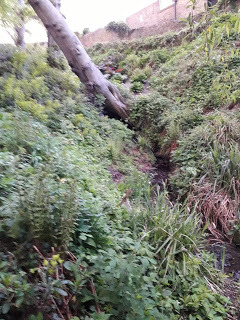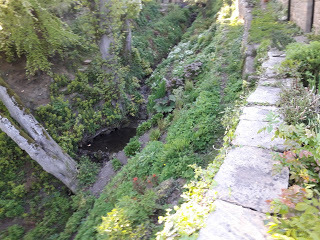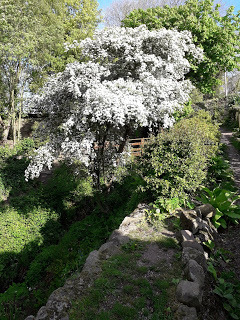Introducing the site -- Wilding at the Dene
 Basically if I am going to talk about the dene, you will need to know about the site. We are on a bend in the road and the wooded area at the top of the picture is us. The label is for the care home, but on the wrong house as that is a newer house which was built in their orchard. The house was built in 1908 and has had 5 or so owners. Prior to that, it was part of a farm. Someone disappeared in the Australian outback and had to be declared dead before it was broken up in the late 19th century but that is about as exciting as the history gets. I have no idea how the mysterious got that strip of land but would like to think it had something to do with the Earls of Derwentwater as it is as far as I can remember the Greenwich Catholic trust.
Basically if I am going to talk about the dene, you will need to know about the site. We are on a bend in the road and the wooded area at the top of the picture is us. The label is for the care home, but on the wrong house as that is a newer house which was built in their orchard. The house was built in 1908 and has had 5 or so owners. Prior to that, it was part of a farm. Someone disappeared in the Australian outback and had to be declared dead before it was broken up in the late 19th century but that is about as exciting as the history gets. I have no idea how the mysterious got that strip of land but would like to think it had something to do with the Earls of Derwentwater as it is as far as I can remember the Greenwich Catholic trust.
 Standing near the willows,
Standing near the willows,on the footpath side of the dene
I am pretty sure the dene part was ancient woodland as there are wild garlic, and white anemones in the spring. Various strips of land were added, particularly in the early years. I suspect they had to site the house differently and had to purchase more land. That part has the remains of being formal and to the front. The dene is to the side. And then in the 1950s, the bit over the bridge was added. This period was supposed to be a bit of heyday for the garden. In the 1960s, the property was sold to the Hedleys who had it until Mrs Hedley went into a home in the early 1990s. A couple bought it to do it up and then promptly decided to get a divorce. It rapidly went back on the market and we eventually purchased it for a decent price in 1996. I suspect most people thought something was really wrong with the house as lots of people had viewed it when Mrs Hedley sold it. Mrs Hedley was a keen gardener (president of the British desert cactus society in the 1960’s – hence the greenhouse) but frail in her later years. For most of her tenure, the dene part was not managed. In the end the garden became too much, even though she had a gardener whom I met when I first moved here. He said that she liked to think about the birds. The people before us were keen on trimming hedges and that is about all. When just before we moved, the greenhouse was destroyed by a car, the wife directed the builders to throw all glass down into the dene as it was bound to wash away and no one went there anyway. I spent a great deal of time hauling broken glass out that first winter so that the children would not get hurt.
 Looking at the middle poolWhat all of this means for the garden is that when we took over, there were various plants from various eras. Gardening goes in fashions and some plants are more popular during certain eras. Know the plant and sometimes you can hazard a guess when they were planted. For example we have a profusion of snowdrops which I believe are Galanthus Samuel Arthnott – they were known from the 1900s but first exhibited in 1951 so I suspect the first plantings were done in the 1950s. There is also a gold dust plant and a few other popular 1950’s specimens in what we call the winter garden (we can see it in the winter) just over the bridge and so I suspect that part was planted up in the 1950s and then left when the Hedleys took over. When woodland is not managed, it closes down and reverts to deep shade which many garden birds actively avoid. So while she might have liked to think about the birds, there were very few birds here when we arrived. There were also very few perches for birds in the more formal part of the garden. One of the first things we did was to get the tree surgeon in and get the trees trimmed and the scrub sorted. We also trimmed back the ivy and uncovered long neglected bushes. We had so many bonfires that winter (getting rid of old fences in the main) that when the barn further down the bank went up in smoke, our next neighbour phoned to see if we were busy burning again. I replied – In a gale? I ran to the window and saw flames further down the road. My children were delighted to watch the firemen arrive and hook up the hoses. Alas the barn burnt to the ground and to this day remains a concrete shell.
Looking at the middle poolWhat all of this means for the garden is that when we took over, there were various plants from various eras. Gardening goes in fashions and some plants are more popular during certain eras. Know the plant and sometimes you can hazard a guess when they were planted. For example we have a profusion of snowdrops which I believe are Galanthus Samuel Arthnott – they were known from the 1900s but first exhibited in 1951 so I suspect the first plantings were done in the 1950s. There is also a gold dust plant and a few other popular 1950’s specimens in what we call the winter garden (we can see it in the winter) just over the bridge and so I suspect that part was planted up in the 1950s and then left when the Hedleys took over. When woodland is not managed, it closes down and reverts to deep shade which many garden birds actively avoid. So while she might have liked to think about the birds, there were very few birds here when we arrived. There were also very few perches for birds in the more formal part of the garden. One of the first things we did was to get the tree surgeon in and get the trees trimmed and the scrub sorted. We also trimmed back the ivy and uncovered long neglected bushes. We had so many bonfires that winter (getting rid of old fences in the main) that when the barn further down the bank went up in smoke, our next neighbour phoned to see if we were busy burning again. I replied – In a gale? I ran to the window and saw flames further down the road. My children were delighted to watch the firemen arrive and hook up the hoses. Alas the barn burnt to the ground and to this day remains a concrete shell.
 Looking up towards the bridge at the hawthorn'
Looking up towards the bridge at the hawthorn'sweet chestnut behind
on the house side of the deneThe stream is connected to an old farm pond which sometimes the farmer neglects. It used to run the gin-gan. One year, we had the firemen back out pumping the pond as a sheep had died and blocked it. Had the Victorian earthworks gone, the entire village would have been threatened. The stream also serves as a storm overflow. Sometimes the farmers do discharges and this results in incidents. But no pesticides have been used for years as far as I can figure. We uncovered paths and found bits of the garden that we had not quite realised existed that first winter. Sometimes it was obvious that certain things were once a specific garden but trees had grown far too big. The conifer by the greenhouse was a case in point but a huge focal point from the village. That is until 2013 when a storm hit and blew it into the greenhouse. The sweet chestnut now has room to grow.There are loads of levels to this garden – it is in a small wooded valley and therefore pathways and parapets. Many of the walls have ivy growing up. And as I suffer from ecological tidiness disorder, I have a tendency to cut the ivy every so often so that it stays on the walls, doesn’t swamp plants and we can see the garden. We do it in the winter so that the birds are not nesting, and it does return. However, I suspect this has to change and beating myself up over the past is not going to help matters. There is a balance to be struck and I suspect I have gone too far on the side of human tidiness rather than benign neglect. It is going to have to be something I work on – not tidying things up too much. And I can’t beat myself up too much. It is just things are going to have to change but I had to physically stop myself pulling ivy out of the wall by the cars this morning.
Published on May 21, 2019 03:11
No comments have been added yet.



